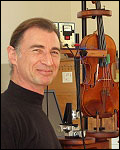Joseph Curtin completed his first violin in 1978, and has worked as a maker in Toronto, Paris, and Cremona. In 1985 he and Gregg Alf established the firm of Curtin & Alf in Ann Arbor, Michigan. Curtin opened his own studios in 1997. Along with researcher Fan Tao, Curtin is founder and co-director of the VSA Oberlin Acoustics Workshop. He has lectured on violin making at universities and professional associations throughout America and Europe.
▪ bio current as of 2009

